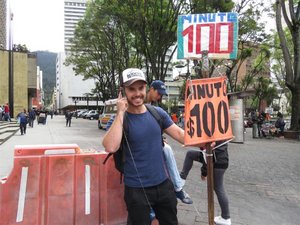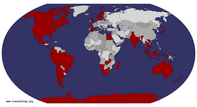Advertisement
Published: December 25th 2017

 Tommy explaining the Bogota 'phone box'
Tommy explaining the Bogota 'phone box'
People go to one of these stands to make phone calls. The owner asks for the number you want to call then selects the appropriate service provider. The phones hang from the hand held post and the 100 is the cost of call per minute. The lady was too shy to pose so Tommy stood in.Geo: 4.60987, -74.082
Bogota 15 - 21 December 2015
It was an easy journey from Quito to Bogota and by 3am we were in bed, so much easier than the alternative, a 28 hour bus ride!
When we set off travelling in South America we were not sure if we would venture into Colombia but listening to the travellers who came from there reassured us and we decided to give it a try. So far it has been fascinating.
I deliberately used the title for the blog, Bogota and Beyond, because that is the name of the tour company set up by Tommy, Ana Maria, his Colombian girlfriend and another Australian, Simon. Then if anyone googles the name they might find this blog. Bogota & Beyond is more than just a tour company. It has the aim of helping bring about change in Colombia which is struggling to overcome more than 50 years of civil war, drug wars, crime and fear instilled by paramilitaries and other gangs. They want to help visitors perceive the country in a more positive light, showing them the beautiful churches, other impressive buildings of various periods, world class museums, taking them hiking in wonderful countryside, helping them learn of the
indigenous cultures from the area and, last but most importantly, whenever possible introducing them to the friendly and welcoming Colombian people.
Another part of their strategy is to train Colombians, many of whom are students, to act as guides and learn about their own country as until recent years it has been too dangerous to travel. Other agencies are also working to bring about change, one of the main ones being Bogota Humana which has numerous projects trying to improve the city and making it a good place for humans to live. It is all about reclaiming the streets. In the late 40s the Bogotazas took place, rioting that lead to the civil war and created the environment for lawlessness to thrive. La Candelaria, the old part of town, had many beautiful houses where rich people lived but as a result of the riots they eventually moved north away from this area. It became very run down with lots of dilapidated and derelect properties but now there is a lot of investment in the area and many of the buildings have been renovated, some by non-Colombians, and a huge number of hostels and small hotels are springing up.
This has brought new

 Local delicacy -
Local delicacy -
Bread and cheese to dip in hot chocolate - better than it sounds!energy and optimism. Each night there was music in Bolivar square as well as in other places. Street theatre, markets, Christmas activities, numerous Nativity scenes and special Christmas lighting all help to encourage people to walk around and enjoy the city.
Tommy, accompanied by Alejandro, a student, took us walking around the La Candelaria district to see the street art, try out delicious local foods, visit churches and get a feel for the area. We spotted the 'green people' perched on top of buildings. These statues are the work of artist Jorge Olave who is representing ordinary people who live in the city. There is a huge amount of graffiti on the buildings. Some owners are using special paint to minimise the problem, others are having walls painted with all kinds of images as the graffiti scribblers seem to respect these and mostly leave them untouched. Some are pleasant and entertaining or funny but others are stunning and all are an improvement on' tag' graffiti. Alejandro provided lots of information about student life as well as the history of the city.
We could have walked around on our own but we would never have learnt as much or had the knowledge
(or courage) to try local foods and chicha, an alcoholic corn drink. As previously on our trip with Tommy in Australia he seems to know everyone, or if he doesn't he starts chatting to them and soon will! It is a great gift that he has to be able to connect with people in this way and makes the whole experience much more interesting than just sight-seeing.
The next day we took a Bogota and Beyond tour to Laguna Guatavita and the Salt Cathedral. It was a great day out with Tommy, our driver who is Alejandro's father and called El Don for short and two others. El Don is a charming gentleman who looked after us very well, even carrying Jim's back pack much of the time. The Laguna is thought to have been one of the places that inspired the legend of El Dorado as the Muisca people who lived there carried out rituals that involved throwing offerings of gold, silver and emeralds into the lake.
Their Cacique or leader was selected at an early age and then trained to take on the role. From the age of 14 - 23 he was isolated and taught all the skills
he would need as well as meditation and self control. Then he was taken to the Laguna, painted in gold, and taken to the centre of the lake where he made offerings and immersed himself. On his return to the shore everyone made offerings by throwing valuable items into the water , one for every good aspect of their lives, eg a wife, a child, good harvest etc. This was a way of welcoming the new Cacique who was then taken to meet his wife to be for the first time. She also had been selected from an early age and prepared for her future life. The Caciqua, as she was called, had an important role as she could veto decisions made by the Cacique.
After the Laguna we went to the weird and wonderful Salt Cathedral. This is a huge salt mine which is still in operation but in an older part there are huge caverns open to the public. Before the miners started their shift they needed to pray so a chapel was available in a space in the mine. A vast amount of money has been spent to make this a tourist attraction, built on this theme of
religion in the mine. There are 12 Stations of the Cross and two chapels hewn out of the salt. My experience of Stations of the Cross (representations of points on Jesus's journey up to the Cross and Crucifixion) lead me to expect pictures representing certain moments on this journey such as when Jesus falls. However these Stations of the Cross consist of huge crosses carved out of the salt and illuminated. It makes for some very impressive, if bizarre, images especially as Angels lurk in out of the way places watching as you pass by. The chapel at the end of the walk is visually stunning. Well worth visiting!
I really can't praise Bogota and Beyond enough not just because of their interesting tours and activities but because of their ideals and their commitment to improving life in Colombia for everyone. Anyone visiting Bogota should check them out.
On our return to Bogota, Ana Maria cooked a delicious meal for 8 of us of Ajiaco, the local dish of potato soup with chicken to which you add to your own taste, cream, capers, rice and avocado. It was a lovely evening and brought to an end two very special days that
we had spent with Tommy and friends.
The next day we went to the Museo de Oro and the Museo Botero. The Gold Museum is unbelievable. There is so much gold in there that the doors to some rooms are about 50 centimetres thick. It is like walking into a vast safe! The artefacts demonstrate the skill of the metal work from as early as 4,000 years ago. However the design and production of gold items was integral to the use of power and religion in the indigenous societies. The Caciques demonstrated their power and prestige through their gold adornments and their posture. The Shamans did the same and their adornments connected them to the three different levels of the Universe in which they believed. They often wore symbols of bats as it was believed the Shaman could fly like bats between the different levels when they took coca and went into trances. One Shaman is said to have flown from Bogota to Santa Marta (approximately 460 miles ) in a trance!
Fernando Botero is a well known Colombian artist who bequeathed much of his own work as well as his collection of work of Picasso, Renoir, Cezanne, Sisley, Lucien Freud and
Henry Moore amongst others to the country and it is now housed in the museum of his name. Everyone and everything he painted is what you might call 'chubby'. It was supposedly a form of political comment as he represented the 'bloated' elite. However he also portrayed working people in the same way, as well as animals and children. Even his still lifes are chubby - see the Pear! As he was from a wealthy family himself there is some controversy about his 'political commentary'.
We have spent six days in Bogota ( population almost 8 million) and there is still much more to see so as we fly out of here at the end of January we will have another couple of days here then. It is the most European of the South American cities we have encountered so far. In fact some buildings in Bolivar square are reminiscent of London, then I discovered that they were built by an English architect, Thomas Reed. The north of the city houses the financial district and is very cosmopolitan. There are still problems, high levels of poverty and a large number of people displaced from rural areas as a result of the
war and paramilitary groups evicting local populations, but the city has so much to build on we can only hope the investment and efforts being made to improve the environment will be successful and make life easier for people here. Everywhere we look there are squares being cleaned up, buildings being renovated, others being jet-cleaned etc. If tourists can move on from the past and see what is happening here now that will add impetus to the change process. Bogota has certainly been a surprise for us and we can only hope we enjoy the rest of Colombia as much.
Tomorrow we fly to Cartagena for Christmas. We hope all your plans for the holiday are on track and we wish you all a Happy Christmas and Peaceful New Year, and we will be in touch again probably from Santa Marta on the north coast of Colombia.
Advertisement
Tot: 0.136s; Tpl: 0.014s; cc: 14; qc: 41; dbt: 0.0579s; 1; m:domysql w:travelblog (10.17.0.13); sld: 1;
; mem: 1.2mb





















Pauline
non-member comment
Wouldn't like that on the front of my house!